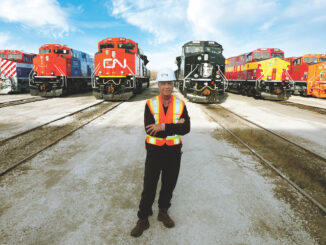TORONTO, Ontario — Fifty years ago this month, Canadian Pacific Railway revolutionized North American transportation with the introduction of the intermodal freight system.
From its launch on the night of Dec. 1, 1952, as a single service – carrying truck trailers on railway flat cars between Toronto and Montreal – it has grown into a wide range of fast and efficient services that deliver reliable transportation through 21 terminals across the CPR’s transcontinental, cross-border rail network.
“We’ve become the largest segment of CPR’s business,” said Lawre Allen, CPR vice-president, intermodal and automotive. “This is a market where ingenuity distinguishes the players. We have brought some very creative thinking to the business. CPR has innovative intermodal products for long-, medium- and short-haul corridors. Today, CPR Intermodal functions more like a trucking company than a railway.”
CPR Intermodal weds trains with the flexibility of local truck delivery and pick-up. It capitalizes on the benefits of safe and environmentally friendly rail transportation to replace long-haul trucking. This frees up trucks, drivers and highway capacity that can be better used for other purposes. By reducing long-haul trucking, it also reduces taxpayer-funded highway maintenance costs. A single CPR intermodal train can haul the equivalent of 300 trucks.
In 2001, CPR Intermodal generated Cdn.$801 million and 917,000 loads. Intermodal has been CPR’s leading revenue growth performer through the first three quarters of 2002, increasing $43 million or 7 per cent over the same period in 2001. Revenue has grown by nearly $200 million or 30 per cent in the last five years.
“We’ve been lucky to piggyback on to this service for 36 of its 50 years,” said Ron Tepper, president of Consolidated Fastfrate, Canada’s largest privately owned freight forwarder. “As a less-than-truckload carrier, we have to be able to tell shippers where their freight is every step of the way and deliver it with less than 15 minutes of leeway, even though it travels thousands of kilometres. CPR has created something no one thought possible even 10 years ago, let alone 50.”
CPR’s intermodal strength is partly rooted in the electronic customs pre-clearance systems it pioneered in the early 1990s. Detailed advance shipment data and electronic shipment tracking have made cross-border trade by rail more secure and efficient. This summer, CPR’s track record and smart clearance systems helped make it the first railway approved under Canada’s new Customs Self-Assessment program. This gives CSA-designated shippers a fast lane into Canada on CPR.
CPR’s well-timed investments in equipment, terminals and information technology have enabled it to stay ahead of intermodal’s fast-paced growth. In the last five years, CPR has rebuilt its entire intermodal infrastructure, expanding existing terminals and building new ones.
“There is still more to gain,” Allen said. “Traffic growth should continue to come from small shippers who take advantage of the same custom-designed service our larger customers have enjoyed for years. With the right combination of service and price, we can shift more traffic off the highways and onto rail to the benefit of shippers, consumers, taxpayers and CPR. Our 50 years of success proves that.
CPR’s 14,000-mile network serves the principal centres of Canada, from Montreal to Vancouver, and the U.S. Northeast and Midwest regions. CPR feeds directly into the Chicago hub from the East and West coasts. Alliances with other carriers extend CPR’s market reach beyond its own network and into the major business centres of Mexico.



